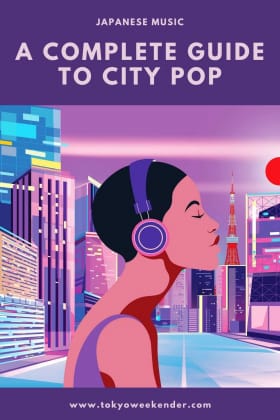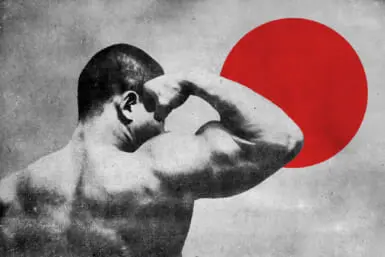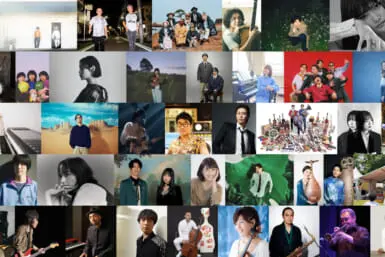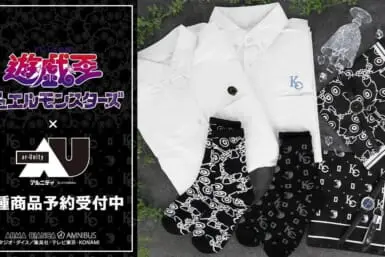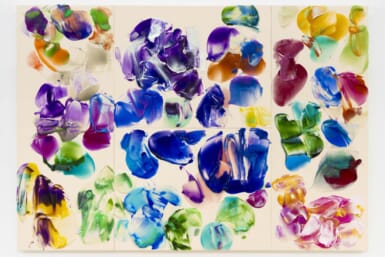In bare terms, city pop was, like Shibuya-kei or kayokyoku, simply the name given to define another era of Japanese pop music. At first glance, its features of funk, disco, R&B, soul and adult-orientated rock (AOR) seem unremarkable for the 1970s and ’80s, perhaps even a subplot in the homogenization of global pop music.
That is, however, where city pop’s indistinctions end. City pop wasn’t just the Japanese equivalent of easy-listening music but some of the most viscerally cinematic and compositionally complex pop ever made. It was a style of circumstance, a product of the optimism, prosperity and security of Japan’s economic bubble of the 1970s and 1980s and mirroring of the futurism and luxury of sprawling cities and increased wealth.
At its very roots, city pop was also the manifestation of a more fundamental transformation in Japanese pop music. It stemmed from the 1971 release of, and ensuing debate around, Happy End’s second record Kazemachi Roman (or Wind City Romance) – the closest modern Japanese pop has come to a “moment,” or the kind of event that can ostensibly be seen to have transformed the trajectory of the production and consumption of popular art.
A humble folk rock and pop masterpiece that leaned heavily on American styles, Kazemachi Roman arrived with one crucial difference to its Japanese equivalents at the time: it was sung in Japanese.
The City Pop Revolution
Happy End revolted against the divide between foreign rock ’n’ roll, thought by many to have been unsuitable for singing in the Japanese language, and kayokyoku, a sentimental style of Showa-era pop deemed more appropriate for the structure and tone of the Japanese language. The popularity of Happy End’s debut and Kazemachi Roman upended the “Japanese-language rock controversy,” but the repercussions have conceivably revolutionized most avenues of modern Japanese popular music since.
Few styles were as defined by the success of Happy End quite so obviously – or immediately – as city pop. Artists took advantage of the newfound pliability of the Japanese language to embrace opulent, fashionable foreign styles such as disco, funk, boogie, lounge, AOR and exotica. Japanese musicians, without the restraints of cultural norms that would usually limit these genres’ fusion, were free to innovate as they wished, creating a soundtrack just as boundless as the economic growth of post-war Japan.
After the breakup of Happy End in 1973, its members (Haruomi Hosono, Shigeru Suzuki, Eiichi Ohtaki and Takashi Matsumoto) continued to pioneer city pop. They would be decisive performers on an absurd number of the style’s most essential and popular works, as well as set precedents for complex songwriting, diverse styles and technical play.
Arrangers like Ginji Ito, Ryuichi Sakamoto, Masutaka Matsutoya and Tatsuro Yamashita met vocalists such as Taeko Ohnuki, Miki Matsubara, Minako Yoshida and Junko Ohashi, forming songwriting partnerships both defined by distinct idiosyncrasies and rife with collaboration from across the pop landscape. As much as each artist had their own draw, certain commonalities – a Hosono bassline, some Tetsuo Hayashi drumming, a Jake H. Concepcion sax solo – often drew these records together.
The nature of city pop as a chameleonic style, defined equally by its aspirations, context and lyrical freedom as a series of set stylistic features, makes it difficult to categorize, dissect or divide neatly into themes (its most distinguishable subgenre, techno-kayo, warrants another article in itself). After all, city pop not only accounted for almost two decades of Japanese pop music but, despite a decline during the “Lost Decade” of the 1990s, has never really gone away. It remains profoundly influential among modern Japanese musicians and, due to fervent bloggers, the YouTube algorithm and its sampling by throngs of hip hop and vapourwave artists, holds a genuinely global audience.
One can stumble across different lists of great city pop artists and find entirely different results, each with their own perfectly reasonable justifications. There have been hundreds of city pop artists and dozens of those are important in some way or another. As such, here I’ll focus on city pop through its key themes and features, from its beginnings in the mid ‘70s up to its heyday and popular decline throughout the ‘80s, and attempt to condense the genre into five of its most defining works.
Sugar Babe, ‘Songs’ (1975)
(Niagara)
Happy End opened the floodgates in terms of the potential of foreign music styles in the Japanese language but, until the mid-Seventies, that potential was mostly limited to blues rock and hard rock (sometimes termed the beginning of “New Music”). When Sugar Babe, principally a duo of Taeko Ohnuki and Tatsuro Yamashita, took to stages in Tokyo with their take on American pop, they were famously booed off. Sugar Babe formed and broke up within three years (1973-76), to little fanfare – their singular record, 1975’s Songs, initially sold badly and the band’s members were intent on different artistic destinies.
Songs is now considered one of city pop’s foundational and most consequential records. It’s credited with extensive use of major seventh chords – apparently scarce in Japanese pop music of the time – as well as breaking ground with its soulful take on softer pop rock. In the years following its release, Songs didn’t just popularize the sounds within its work but propagated an entirely different mindset from Japanese musicians towards borrowing the aesthetics of American – and increasingly African American – popular art.
Burdened by such significance, it’s often easy to forget the strength of Songs in terms of its actual music. Full of bright jazz chords and swooning vocal harmonies, it is a tremendously catchy and industriously consistent album. Produced by Happy End’s Eiichi Ohtaki (and released on his Niagara label), it has typical Ohtaki finesse but also the signature quality of the future careers of Yamashita and Ohnuki.
“Ohnuki and Yamashita became two of city pop’s most significant and dependable artists”
Over the next decade, Ohnuki and Yamashita became two of city pop’s most significant and dependable artists. Ohnuki’s solo career thrived in collaboration with Ryuichi Sakamoto, initially producing intricately-arranged jazz-pop before exploring artier styles associated with French pop and European chamber music. Come the fall of disco and the advent of synthesizer-driven pop, both she and Sakamoto were crucial in the development of techno-kayo. Yamashita, as I’ll get on to later, was just as prolific, while other members of Sugar Babe (not necessarily on Songs) – notably Ginji Ito and Kunio Muramatsu – similarly made significant impact on the scene.
As difficult it is to find a Japanese pop album unindebted to Happy End, it is equally difficult to find a record prior to Songs that so boldly incorporated American pop styles. There were, however, more gradual routes into city pop. One was through jazz fusion, vocal jazz and ballads, straddling kayōkyoku and newer styles. While the likes of Tin Pan Alley and Casiopea more radically worked with fusion, singers like Kimiko Kasai, Minako Yoshida and Junko Ohashi increasingly built elements of disco, funk and R&B into their balladry.
See Also: Ohnuki’s Sunshower (1977) and Mignonne (1978) are unmissable city pop masterpieces as deserving of a place in this list as anything else here, while Ginji Ito’s Deadly Drive (1977), with its light funk and sound effects, remains simultaneously one of the most danceable and odd early genre works. For an insight into the jazzier, more ballad-heavy early records, there are few better than the gentle R&B of Minako Yoshida’s Tobira no Fuyu (1973) or Junko Ohashi’s magnificently-sung Paper Moon (1976).
Haruomi Hosono / Shigeru Suzuki / Tatsuro Yamashita, ‘Pacific’ (1978)
(CBS/Sony)
The “New Music” and city pop artists of the 1970s and ’80s were the first generation of Japanese musicians to mature in a post-war Japan that was significantly under the influence of American pop culture. The Far East Network (FEN), an American military radio station broadcast from the Yokota Air Force Base outside Tokyo, provided access to American music. An influence behind Ohnuki’s Sugar Babe work and the reason for Yamashita’s love of the Beach Boys and Barry Manilow, the FEN spawned a generation of Japanese musicians more in-tune with American music culture than ever before.
Haruomi Hosono was another of these musicians, a devotee of the American psychedelic movement who, in his early career, felt more connected with contemporary American music culture than traditional Japanese styles. He’d been a member of Happy End and Tin Pan Alley, while his solo work had dabbled in psychedelic folk, yacht rock and, crucially, exotica.
Exotica, the strange style of easy-listening music based on Western musicians’ imaginary (and often imperialist) constructions of the ‘exotic’ and ‘other’, was popular on the FEN in the late ‘50s. The beaming of tunes intending to replicate far-flung places to those very places seemed strange to Hosono indeed, and he saw the opportunity to have some fun with it:
“With Martin Denny, the exotica is kind of fake. But I am real! I am the target of that western exotica. So what I wanted to make was exotica from an oriental perspective.”
While Hosono was the most vocal in poking fun at Western exoticism, he wasn’t the only Japanese musician doing it. The finest example of such subverted exotica was Pacific, a collaboration between Hosono, Shigeru Suzuki and Tatsuro Yamashita.
Suzuki had been with Hosono in the self-Orientalizing works of Happy End, Tin Pan Alley and Hosono’s solo records Tropical Dandy (1977) and Paraiso (1978). Since Sugar Babe, Yamashita had recorded in California and released two solo records, proving to be a steady machine of high-quality city pop. Pacific was a blend of entirely instrumental smooth jazz, ‘70s funk, fusion and city pop, including three tracks by Hosono, three by Suzuki and two by Yamashita – though they all performed on nearly every track.
“Pacific is a beautiful record, its sprightly absurdity built out of genuinely fantastic music.”
Pacific is a beautiful record, its sprightly absurdity built out of genuinely fantastic music. It’s also a necessary city pop work containing key tropes that ran throughout the style’s history. Capturing the collaborative element of city pop, not only were Hosono, Suzuki and Yamashita all big names but they were joined by a community of prolific musicians. Ryuichi Sakamoto, Yukihiro Takahashi (who both eventually joined Hosono in Yellow Magic Orchestra), Hidefumi Toki, Kenji Omura, Nobu Saito, Tatsuo Hayashi and many, many others were evidence of the cross-pollination on so many of the genre’s leading works.
Yet despite its collaborative nature, made for an industry corporation and poking fun at exotica, Pacific also displayed what has come to define the visual and audial aesthetics of city pop. The vivacity and singularity of its thematic imagination is obvious. Though not every city pop artist had the Hosono’s desire for cheeky postcolonial critique; be it the beach, resort, town, city, surfing or driving, Pacific (and the Sony Image Series of which it was the first installment) was an early display of city pop artists’ fondness for singularly-themed, situationally aspiratory albums – which remained one of the genre’s most identifiable features.
See Also: Hiroshi Sato’s dreamy, equally surreal lounge funk epic Orient (1979) and the rest of the Sony Music Series, particularly The Aegean Sea (1979) with Hosono, Takahiko Ishikawa and Masataka Matsutoya and Memories in Beach House by Seaside Lovers, the trio of Sato, Matsutoya and Akira Inoue.
Tatsuro Yamashita, ‘For You’ (1982)
(Air)
Concerning the style of city pop informed by funk, boogie, doo wop and soul – that is, the strain left largely undriven by synthesizers- the early Eighties saw both its popular peak and some of its greatest works. Albums by Takako Mamiya, Eiichi Ohtaki, Makoto Matsushita and Yoshino Fujimaru were all significant in their own right, covering broad musical ground ranging from jazz-pop to progressive rock, sunshine pop to synth-funk.
By the time he released For You, Tatsuro Yamashita, otherwise known for his seasonal staple “Christmas Eve”, had already enjoyed significant commercial and artistic success. On top of Sugar Babe and Pacific, he’d joined Niagara Triangle with Ohtaki and Ito and performed on albums by Ohnuki, Yoshida, Yumi Matsutoya, EPO and Mariya Takeuchi. Under his own name, Yamashita’s fifth record Ride on Time (1980) had brought him his first number one album and single.
“Like so many city pop records it is distinguished by its carefree optimism”
Yamashita’s artisanal pop music, characterized by his scholarly approach to harmony and chorus and the fact that he recorded and produced so much of his music himself, flourished most freely on For You. In itself, For You seemingly offered little to differentiate itself from its majorly popular peers. Like so many city pop records it is distinguished by its carefree optimism, timeless performances and light-hearted disregard for the conventions of the styles from which it borrowed. Its cover, provided by prolific artwork-maker Eizin Suzuki, is typical of the distinctive blend of blissful, pristine pop art (with hints of surrealism and American advertisements) that glazed many of the genre’s seminal works.
For You was, however, Yamashita’s first record entirely unburdened by budgetary restraints. It shimmered with the fuller realization of Yamashita’s ambitions, a record poised to sound huge at every opportunity. The participation of dozens of musicians ensured that every track, slow ballad or single, had drama and scale. For You wasn’t necessarily a unique city pop album (indeed, two of its tracks were re-recordings of tunes Yamashita had written for Takeuchi’s 1980 album Miss M.) but it was one of the most ostentatious.
Yamashita tailored together elements of soul, funk, sunshine pop and boogie without getting drawn into anything that could be heard as pretentious or convoluted. From its lyrics and instrumental bombast to its liner notes (“and this Album was made especially FOR YOU!”), For You was as shamelessly cheesy as so much iconic pop can’t help but be. That mixture of meticulousness and scale has ensured that, even 40 years later, For You still succeeds as profound pop music.
See Also: Mariya Takeuchi’s “Plastic Love”, another pop masterpiece written by Yamashita and quite possibly the most famous city pop song this side of the ‘80s; as well Eiichi Ohtaki’s Wall-of-Sound-inspired A Long Vacation (1981) and Makoto Matsushita’s bass-heavy First Light (1981), both watertight classics.
Junko Ohashi, ‘Magical’ (1983)
(Phillips)
City pop was not, however, solely dominated by those orbiting Hosono, Yamashita and Sakamoto. Nor was it even led by male performers. Women were the face of city pop, and the themes, poetics and hooks developed by female singers and lyricists amounted to just as significant a cultural shift as the work by arrangers and composers.
The development of catchy vocals and metaphorical lyrics was pursued by singers such as Minako Yoshida, Miki Matsubara, Noriko Matsumoto and Rajie, all of whom were vital in transforming the subjects and singing styles of kayōkyoku into something more compatible with the instrumental revolution burgeoning in the studio behind them.
Among the boldest of these was Junko Ohashi. She grew from the ballading side of city pop and her work, mostly arranged by her husband Ken Sato, was set apart by Ohashi’s signature powerful vocals. Stellar early albums Paper Moon (1976) and Full House (1979) were more pragmatic than many of their peers; though her instrumentals grew more grooved, discoed and Americanized, her voice was always the centerpiece, flitting measuredly between funk, disco and ballads.
Ohashi’s most glamorous works arrived in the early ‘80s with the popularization of synth-funk, a style that replaced many of the melodic aspects of funk with melodies from synthesizers. 1983’s Magical collected some of these tracks into a compilation of greatest hits, wrapped in a record sleeve that oozed city pop’s chic, urban aesthetic.
Most remarkable of Magical wasn’t its synth-funk style – a relatively common feature of works by Toshiki Kadomatsu, Yurie Kokubu, Hitomi “Penny” Tohyama and others – but the strength and adaptability of Ohashi’s vocals. She howled across the disc, tracks like “I Love You So” and “Telephone Number” made memorable by unusual and inimitable vocal melodies. Though others (notably Yoshida) had similarly bellowing deliveries, no one was quite as thunderous as Ohashi, nor as adaptable.
Many of city pop’s female artists would command more electronic styles, offering takes on metropolitan pop that were more mechanical and technologically ambitious, wilder and fast-paced. Ohashi never fully ventured into techno-kayo but, thanks to Magical and her early works, she held sway over some of city pop’s most prominent styles and embodied the genre’s space as a platform for diverse vocalists of exceptional quality.
See Also: Minako Yoshida’s Twilight Zone (1977) was more soulful and blues-infected but, like Ohashi, Yoshida sang to the rafters. Rajie’s all-star effort Love Heart (1978) and Junko Yagami’s Full Moon (1983) are both similarly elegant, polished pop records.
Toshiki Kadomatsu, ‘After 5 Clash’ (1984)
(Air)
https://www.youtube.com/watch?v=y9AQYPDOCts
When a new pop movement succeeds past its foundational and progressive works, what follows can often feel formulaic or sanitized, saturated by imitators and commercial opportunists. Many of city pop’s pioneering actors split off from the genre in the early ‘80s, several into techno-kayo and some, like Hosono and Sakamoto, into more experimental stuff like progressive electronica.
But city pop had always been somewhat fueled by commercialism. What was left wasn’t just the dregs of an old scene but a cohort of musicians inspired those initial actors, still engrossed in the rich bed of American pop culture. At their lead was Toshiki Kadomatsu, of a generation already inspired by Happy End, Sugar Babe and Casiopea and who was only 20 years old when he released his debut record in 1981.
“Kadomatsu took the reins of all of city pop’s glamour, modernity, grooves and cheese”
Kadomatsu took the reins of all of city pop’s glamour, modernity, grooves and cheese. His early records kept with themes of resorts, sea and summer but it’s his noisy nightlife records that were more distinct from anything else in this list. After 5 Clash, one of his best, was a pacey synth-funk record true to all the flashiness and glitz that many either experienced or aspired to during the peak of Japan’s asset price bubble.
The cover, a kinetic high heel over a buzzing, glinting nightlife city scape, depicts that lifestyle too, but it’s difficult to grasp exactly the kind of optimism that After 5 Clash so embodies. It captured the extravagant heights of the Japanese business class’s economic prosperity – fast cars, lavish leisure and late-night parties – with particular zeal. A lot of city pop was “of its time” but After 5 Clash is more so than most. A brash record that oozes arrogance and sleaze, it epitomized the kind of excess that, during the next decade’s economic stagnation, many looked back upon awkwardly.
In that regard, After 5 Clash seems an appropriate place to leave city pop. The genre thrived throughout the rest of the ‘80s (Kadomatsu’s bestselling work, the entirely instrumental Sea Is a Lady, came out in 1987) but when the bubble plunged in 1992, so did city pop’s popularity in the Japanese pop charts.
In the 2010s, in no small part due to vaporwave, hip hop and YouTube all directing fans to old funk samples, the genre saw a resurgence. Meanwhile, artists like Fujii Kaze, Cero and Awesome City Club have made the style their own, sometimes emulating city pop’s icons and often innovating towards what they imagine the genre should sound like today. And yet, though city pop immeasurably expanded the breadth of Japanese pop and occupies a unique historical place, its finest legacy is the music itself – two decades’ worth of well-crafted, exquisite pop music.


